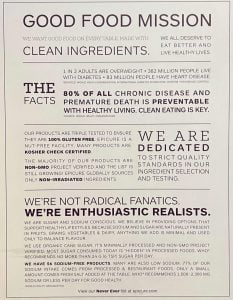Student’s Journey with Giardia Leads to Diagnosis of NCGS
 Little-known fact: The symptoms of chronic giardiasis can mimic gluten intolerance. How can hikers tell the difference?
Little-known fact: The symptoms of chronic giardiasis can mimic gluten intolerance. How can hikers tell the difference?
- Ethan Newman, backpacker.com 1
Anders Johnson hadn’t eaten gluten in nearly a decade.
After coming down with an unidentifiable illness in the summer of 2006 while running high adventure trips at a Boy Scout camp in Southern California, he had been wracked with serious gastrointestinal dysfunction distress, depression, and brain fog. No matter how much he ate, he kept losing weight. At one point, he logged his caloric intake for a college nutrition class and found that he had been eating seven thousand calories a day, despite looking sickly thin. Around Thanksgiving of that year, it got so bad Johnson had to go to an urgent care because he was so dehydrated.
“I ended up failing a good chunk of my classes that semester just because I didn’t have any energy,” Johnson says.”Then I started hitting the doctors really hard, trying to figure it out.”
Amid the myriad possible diseases he discussed with his doctors, they started testing for celiac disease, a genetic autoimmune disorder that causes severe intolerance to gluten. Johnson’s results came back borderline; not definitively positive, but not exactly negative either. He ran with it.
- “I started eating gluten-free. I started regaining mental faculties and started getting a little bit of weight back on me,” Johnson says “Whenever I cheated, it would just throw me back into a downward spiral.”
But doctors never definitively diagnosed Johnson with celiac disease. His doctors wanted to do a biopsy to get a definite answer, but that would require eating gluten again, something Johnson wasn’t willing to chance. Instead, he stuck with his gluten-free diet, which didn’t completely fix his symptoms but seriously improved them. He had to make sure even infinitesimal amounts of gluten wouldn’t end up in his food, like gluten as a binder in spices. Eating rigidly gluten-free can be exhaustingly difficult and makes even simple social engagements involving food complicated, but it was better than the alternative.
- In 2015, however, a college friend who’d had a similarly severe gluten sensitivity texted Johnson that she had eaten a cookie. As it turned out, what that friend had assumed was celiac disease was a very different illness: giardia.
Giardia lamblia 2 occasionally called “beaver fever,” is an easily treatable intestinal parasite, unlike celiac disease. If you’ve been backpacking long enough, you probably know someone who’s gotten it. Giardia is normally an acute infection that causes diarrhea, horrendous gas, and other intestinal malaise, but doctors can corral it easily with antibiotics.
- The chronic form of giardiasis is lesser known, however. The friend sent Johnson medical studies showing how chronic Giardia infection can cause celiac-like symptoms.
“It was like a whole bunch of puzzle pieces fell into place at the same time,” said Johnson. The issue was that he kept testing negative for giardiasis. Johnson wasn’t convinced.
Johnson was a master’s student in microbiology at the time at Idaho State University, so he borrowed some equipment from the school lab.
“I used the procured stains, a microscope, and slides and started conducting samples of myself. So I was making my own slides; staining them and looking for Giardia,” says Johnson.“At the same time, I also had a commercially prepared slide of giardia. Giardia is a protozoan infection, it’s also cyst forming, which provides a means for transmission and survival outside the body. You ingest the cysts, you get infected. So I started hunting for them.”
Johnson took pictures of his sample, along with the commercial one, and presented them to a doctor. Johnson asked the doctor if they could tell which sample was his and which was the commercial sample. They couldn’t. Instead, the doctor prescribed him a cocktail of antibiotics, antifungals, and antiprotozoal medications.
“If my intestines were a warzone, we went full nuclear,” Johnson remarked.
A few weeks after the last round of medication, Johnson wanted to test if he was still sensitive to gluten. Ever the scientist, he set up a double-blind test so that neither he nor the person administering the test knew if the capsule he was taking contained wheat flour or not. On the first round, after waiting 24 hours to see if he would have a reaction, he checked what he took. It was flour.
His body had digested it just fine. He could eat gluten again.
- Dr. Leo Galland, a doctor of internal medicine, describes people like Anders Johnson as having a non-celiac gluten intolerance from chronic giardiasis. “It’s a diagnosis in which you establish that the person has symptoms provoked by gluten, but they don’t have evidence of celiac disease,” said Dr. Galland.
- “The border between those two conditions is fuzzy because it’s not always possible to pin down the diagnosis of celiac disease with a high level of precision.”
Dr. Galland also says that giardiasis can be hard to get accurate results for as well. False negatives from single tests aren’t uncommon.
“Stool sample tests for acute giardiasis are only accurate about 50% of the time, although with three specimens you can get the accuracy up to around 90%,” Galland says.
Chronic giardia, like what Johnson had, can be particularly hard to identify. The tests don’t always show the giardia cysts, and the symptoms don’t necessarily present as the classic intestinal distress and diarrhea, according to Dr. Galland, instead presenting as symptoms as varied as constipation, arthritis, or even dizziness.
Dr. Galland says that if you think you have chronic giardiasis, ask yourself if you think you could have had exposure, like poorly treated water in the backcountry or while traveling. He recommends finding a doctor with experience treating intestinal parasites to order an antigen test, which is much more accurate than microscopy. You can discuss the possibility of an empirical course of treatment with your doctor as well.
Johnson, currently working on his Ph.D. in microbiology in Sweden, recognizes that not everyone will be able to test themselves the way he did for chronic giardiasis. He was lucky enough to have the skills and resources available to him.
“If forty thousand dollars of student loan debt paid for anything, it’s to be able to eat chocolate chip cookies again,” he says.













